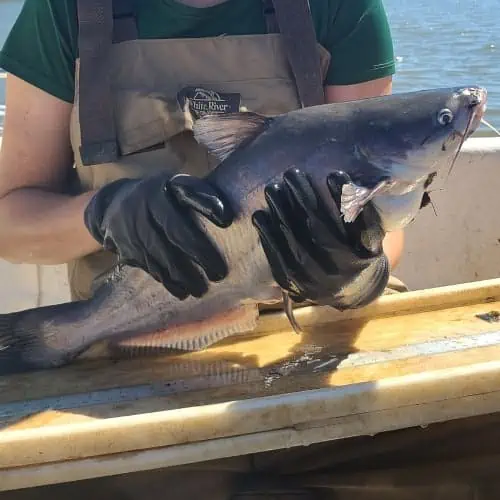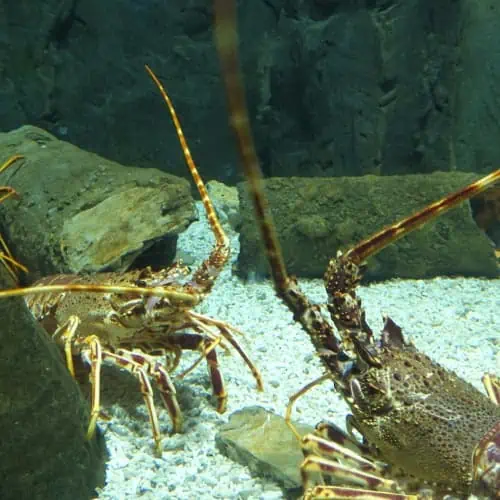What Kind of Food Can I Feed My Catfish
What Food Should You Feed Catfish in Ponds? (Catfish Food Guide)

Catfish are some of the most popular food and sport fish in freshwater systems throughout North America. They are intentionally farmed for their meat in several continents, including Australia, Africa, and Asia. Intensively produced due to high global demand, they can be kept in a variety of artificial pond setups. Among the most commonly cultivated varieties include channel catfish (Ictalurus punctatus) and a blue catfish (I. furcatus) hybrid.
Considered the kings of aquaculture in the US, catfish are able to support an industry with a revenue of hundreds of millions of dollars per year. Ponds as small as one acre can support a thriving population alongside several forage fish and predatory species. Depending on the conditions of the pond and the intentions of the grower, catfish may be kept on an artificial diet to hasten their growth into harvestable sizes.
That being said, the type of food you should feed your catfish has much to do with the species cultivated, where the fingerlings are sourced, and their stocking density. Ornamental catfish stocked in garden ponds, for example, need not be fed with a formulation made for farmed fish, especially if they are accustomed to live food. To comprehend what is best for your fish, it is necessary to familiarize yourself with their natural food preferences. Artificial feeds may often be based on the nutrients fish obtain from their wild diets.
The Wild Catfish Diet

Most types of catfish favor conditions in the shallow, freshwater bodies of tropical to sub-tropical regions. They usually remain in running water, keeping close to the benthos of lakes, ponds, and streams. In these zones, they are likely to find a wide variety of food choices to meet the nutritional needs of juveniles to mature individuals.
The diets of young catfish are limited by the size of their mouth and the developmental stage of their digestive system. Compared to their adult counterparts, they usually consume larger portions of detritus (including decaying animals) and phytoplankton. These food types require less skill to find and would, of course, be more compatible with smaller mouths.
The diets of mature catfish are extremely varied and are significantly influenced by the availability of specific nutrient sources. In highly productive and biodiverse systems, catfish are able to feed on live prey belonging to several taxa. It follows that access to larger prey with higher protein contents can lead to the growth of larger catfish. Below is a list of some of their favorite food choices in the wild. If sourced from a reputable vendor, some of these can be provided as treats in naturalized ponds.
- Crustaceans (crayfish, shrimp, crabs)
- Clams, mussels, and snails
- Small fish
- Aquatic insects and insect larvae
- Amphibians and their larvae
- Sea cucumbers (in marine and estuarine environments)
- Vegetation, phytoplankton, and algae
- Detritus
Feeding Behavior of Catfish

The catfish morphology is designed for survival along the bottom reaches of freshwater systems. The ventral (underside) portion of their cylindrical body is distinctly flattened, allowing them to comfortably remain perched on flat surfaces as they rest or lie in wait for food. Their flattened heads can be used to dislodge substrates and dig holes. They have thus evolved to be bottom or benthic feeders, with a preference for live macrobenthic organisms.
The benthic feeding habits of most catfish species are supported by a sucking mouth and downward-oriented barbels. As they are suction feeders, they are more likely to gulp or swallow their prey whole instead of chewing them into smaller, more easily digestible pieces. This limits what they can consume to items that are much smaller than themselves. The suction force of the mouths of some types of catfish allows them to cling onto objects or walls.
Although wild catfish prefer to feed close to the bottom, those reared in intensive ponds are often fed with floating feeds so that their feeding activity can be observed from the water's surface. In some cases, a combination of both sinking and floating feeds is used. Fingerlings purchased from commercial suppliers of fish fry are usually feed-trained and are well-adjusted to taking feeds from the surface. Note, however, that floating pellets are slightly more expensive than sinking ones.
Feeding Catfish in Intensive Ponds

In intensive aquaculture ponds, catfish are grown to harvest size in as quick and financially sound a manner as possible. They require high-quality commercial feeds with the right ratios of proteins, carbohydrates, and lipids. In areas where the catfish aquaculture industry is well-developed, finding a supplier of feed formulations specifically made for catfish should be straightforward. Moreover, feeds of various sizes to suit the growth phases of catfish should also be available.
Most catfish farms employ a timed feeding method as this is the most economical way of ensuring that most of the stocked catfish are able to consume enough food. If the farmer is able to estimate the average body weight per fish, the total amount of food fed throughout the day should be equal to a small percent of the total fish weight. The water quality and dissolved oxygen levels in the pond would also influence this amount as fully aerated ponds have a higher capacity for large food inputs.
Commercial Feed Quality for Catfish

For catfish production to be a wise investment, you'll need to plan ahead and go over food costs before stocking your fish. The financial costs of commercial feeds can cover around 50% of the total expenses on intensive farms. High-quality catfish feeds are nutritionally well-balanced and contain trace amounts of minerals and vitamins. The specific type of feeds used differs based on the growth stage of the fish, their size at the time of feeding, ambient conditions (season), and health status.
In intensive grow-out ponds, the catfish feeds used tend to have a protein content (typically from soybean meal) that ranges from 26 – 36%. Ideally, the crude protein portion should be about 32% for feeds that are used during warm months or through the peak growth period. In winter, when fish metabolism is slowed, this portion can be reduced to about 26%. Feeds with a lower protein content can also be used in extensively stocked ponds.
Pellet size should be adjusted according to the average length or weight of the fish. Those that weigh at least half a pound can be fed with pellets that measure about ¼ inch (6 mm). Fingerlings are fed with pellets that measure just 1/8 inch to 3/16 inch (3 – 4.8 mm) in diameter. They too require feeds with a crude protein content of about 28 – 32%. Catfish fry, on the other hand, are usually fed with "crumbles" or "fines". These are smaller-sized feeds with markedly high amounts of protein (up to 45%) for rapid development growth. Fry can also be fed with natural food sources, such as tiny insect larvae and zooplankton.
Well-balanced feeds with antibiotics are administered to catfish in ponds experiencing pathogenic outbreaks. When it comes to medicated feeds, there may be strict feeding guidelines in your area. Always make sure to double-check with local experts as the unnecessary provision of antibiotics can lead to wider ecological consequences.
Catfish in Multi-Species Ponds

In smaller, multi-species ponds which are likely stocked in an extensive or conservative manner, catfish need not be fed with supplementary feeds. These ponds are usually cultivated for personal use, to gain a small profit from seasonally harvested fish, or to meet the demands of local anglers. Compared to intensive aquaculture ponds, multi-species ponds are more naturalized and are deliberately fertilized. This is due to the need for vegetation, bottom structure, and ample nutrients – elements that are necessary for a self-sufficient forage base.
A forage base for catfish may include a combination of minnows, sunfish (bluegill and redear sunfish), and threadfin shad. For the forage base to be sustainable, without the need for supplemental feeding with commercial feeds, keep in mind that catfish densities need to be kept at a minimum. They will need to be intermittently harvested as well. If you have a high harvesting capacity, you should be able to stock more catfish and make use of supplementary feeds.
Feeding Catfish in Winter

If your catfish pond has a forage base, you need not worry about your food fish obtaining the necessary nutrients in winter. The fish, which will have significantly lowered metabolic rates, will likely remain close to the pond bottom. At temperatures below 21˚C (70˚F), catfish may begin to feed in a more irregular manner. Once temperatures are brought down to 10˚C (50˚F) or less, they may stop feeding completely.
In intensive ponds that are located in areas with mild winters, catfish may continuously be fed (albeit at a much lower frequency) through winter. Fish farmers may opt to switch to sinking pellets at this time of year as the fish are more likely to feed closer to the warmer pond bottom.
For farms in cooler areas, it is advisable to stop feeding through winter. This is partly because it may be too difficult to evaluate the feeding and growth response of catfish in cool temperatures. Keep in mind that one of the downsides to using sinking pellets is that excess feeds and water quality problems along the pond bottom can go undetected.
A Diet for Ornamental Catfish in Ponds

Ornamental catfish, called plecos, belong to the Loricariidae family of tropical fish from South America. Often raised in indoor tanks and garden ponds, these species maintain an omnivorous diet. They remain close to the bottom of the pond, where they are likely to feed on algae on the surfaces of vegetation, rocks, or along bottom substrates and detritus.
Though plecos can technically survive off of debris and algae, these should not be all that they are fed. For them to remain healthy and live long, they also require a well-balanced and nutritionally rich diet. In ponds with a naturalized bottom, they should be able to find diverse prey items, such as insect larvae and small crustaceans.
If your pond bottom is fully lined and free of bottom substrates, you may need to supplement your pleco's diet with nutritious treats. Many hobbyists believe that their plecos are strictly nocturnal feeders, but this is often the result of misconceptions. Plecos can actually be fed during the day, which is when many of the most popularly cultivated species are most active (if they are comfortable in their environment). You should occasionally be feeding them with some of the following items:
- Bloodworms
- Small insect larvae
- Algae wafers
- Repashy gel food
- Small slices of squash, cucumber, zucchini, and carrots
- Small crustaceans
Source: https://pondinformer.com/catfish-feeding-guide/
Postar um comentário for "What Kind of Food Can I Feed My Catfish"